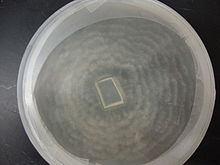
The Hymenochaetales are an order of fungi in the class Agaricomycetes. The order in its current sense is based on molecular research and not on any unifying morphological characteristics. According to one 2008 estimate, the Hymenochaetales contain around 600 species worldwide, mostly corticioid fungi and poroid fungi, but also including several clavarioid fungi and agarics. Species of economic importance include wood decay fungi in the genera Phellinus and Inonotus sensu lato, some of which may cause losses in forestry. Therapeutic properties are claimed for Inonotus obliquus ("chaga") and Phellinus linteus, both of which are now commercially marketed.

Sordariomycetes is a class of fungi in the subdivision Pezizomycotina (Ascomycota). It is the second-largest class of Ascomycota, with a worldwide distribution that mostly accommodates terrestrial based taxa, although several can also be found in aquatic habitats. Some are phytopathogens that can cause leaf, stem, and root diseases in a wide variety of hosts, while other genera can cause diseases in arthropods and mammals.

Mortierella species are soil fungi belonging to the order Mortierellales within the subphylum Mortierellomycotina. The widespread genus contains about 85 species.

Geotrichum candidum is a fungus which is a member of the human microbiome, notably associated with skin, sputum, and faeces where it occurs in 25–30% of specimens. It is common in soil and has been isolated from soil collected around the world, in all continents.

The Cunninghamellaceae are a family of fungi in the order Mucorales.

The Baeomycetales are an order of mostly lichen-forming fungi in the subclass Ostropomycetidae, in the class Lecanoromycetes. It contains 8 families, 33 genera and about 170 species. As a result of molecular phylogenetics research published in the late 2010s, several orders were folded into the Baeomycetales, resulting in a substantial increase in the number of taxa.

The Zoopagomycotina are a subdivision of the fungal division Zygomycota sensu lato. It contains 5 families and 20 genera. Relationships among and within subphyla of Zygomycota are poorly understood, and their monophyly remains in question, so they are sometimes referred to by the informal name zygomycetes.

MortierellalesCaval.-Sm., 1998 is a monotypic fungal order, within the phylum of Zygomycota and the monotypic, division of Mortierellomycota. It contains only 1 known family, MortierellaceaeLuerss., Handb. Syst. Bot. 1: 63. 1877, and 6 genera and around 129 species.

Mucoromycotina is a subphylum of uncertain placement in Fungi. It was considered part of the phylum Zygomycota, but recent phylogenetic studies have shown that it was polyphyletic and thus split into several groups, it is now thought to be a paraphyletic grouping. Mucoromycotina is currently composed of 3 orders, 61 genera, and 325 species. Some common characteristics seen throughout the species include: development of coenocytic mycelium, saprotrophic lifestyles, and filamentous.
Dimargaritales is a monotypic order of fungi in the monotypic Dimargaritomycetes class within the subdivision of Kickxellomycotina.
Echinochlamydosporium is a fungal genus in the Mortierellaceae family of the Zygomycota. The genus is monotypic, containing the single species Echinochlamydosporium variabile, found in China. The fungus grows on juvenile individuals of the soybean cyst nematode.
Gamsiella is a fungal genus in the Mortierellaceae family of the Zygomycota. The genus is monotypic, containing the single species Gamsiella multidivaricata, found in the United States.

The Magnaporthales are an order of fungi within the class Sordariomycetes and subclass Diaporthomycetidae. It has several water based species and genera.

Zoophagus is a genus of zygomycete fungi that preys on rotifers and nematodes. It was established in 1911 by Sommerstorff, who originally considered it to be an oomycete. It is common in a variety of freshwater habitats, such as ponds and sewage treatment plants.

Mortierella polycephala is a saprotrophic fungus with a wide geographical distribution occurring in many different habitats from soil and plants to salt marshes and slate slopes. It is the type species of the genus Mortierella, and was first described in 1863 by Henri Coemans. A characteristic feature of the fungus is the presence of stylospores, which are aerial, spiny resting spores (chlamydospores).
Auxarthron californiense is a fungus within the family Onygenaceae family and one of the type species of the genus Auxarthron. A. californiense is generally distributed around the world and it is frequently found on dung and in soil near the entrances of animal burrows.
Umbelopsis ramanniana is a common and abundant soil fungus. Although the ecological role of this fungus in natural ecosystems is not yet known, it is a cosmopolitan saprotroph in soil, forest leaf litter, in animal dung, and on the spore-producing bodies of ascomycete fungi. Umbelopsis ramanniana has also been found growing as an endophyte within xylem tissue of both healthy and declining conifers, but its exact effect on the plant hosts is unknown. Umbelopsis ramanniana is a representative of a unique group of zygomycete fungi that is distinct from the Mucoromycotina and Mortierellomycotina and instead forms an early diverging lineage within the Mucoralean fungi. Umbelopsis ramanniana is important from a biochemistry and biotechnology perspective because it is highly tolerant to fungicides of benomyl group, and it is oleaginous. Expression of Umbelopsis ramanniana diacylglycerol O-acyltransferase 2A in seed increases oil in soybean without reduction of other important yield parameters. This increase in oil can potentially add over $1 billion to the annual value of soybean crops.

The Urocystidales are an order of fungi within the class Ustilaginomycetes. The order contains 6 families and about 400 genera. They are a sister order to Ustilaginales.
Calcarisporiellaceae is a family of fungi within the subkingdom Mucoromycota. It is the only family in the order Calcarisporiellales, class Calcarisporiellomycetes, subphylum Calcarisporiellomycotina and phylum Calcarisporiellomycota. It contains two known genera, Calcarisporiella and Echinochlamydosporium. The two genera each have one species.

Savoryellaceae is a family of aquatic based fungi. It is the only family in the monotypic order Savoryellales within the class Sordariomycetes, division Ascomycota.

















